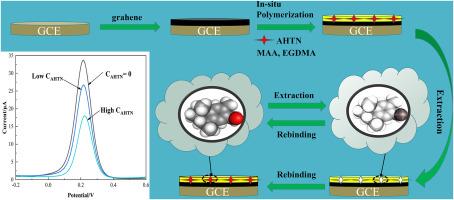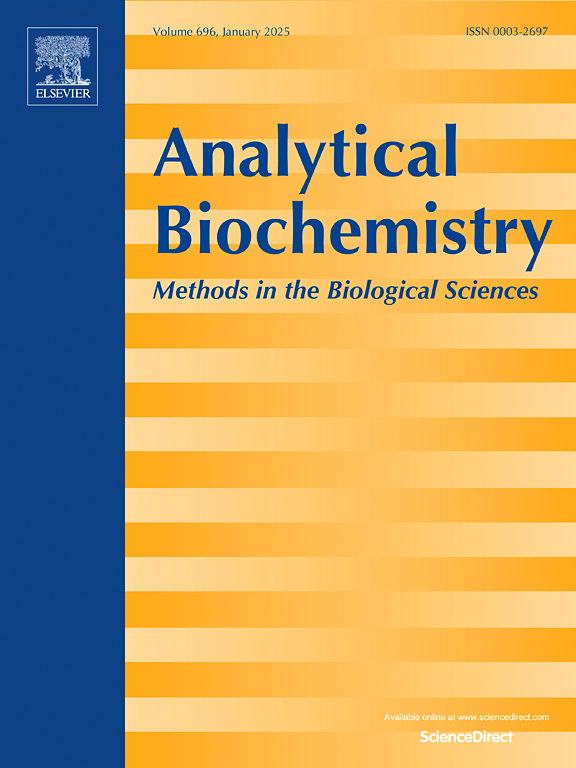一种基于原位聚合的分子印迹电化学传感器,用于快速、选择性地检测水环境中的tonalide
IF 2.6
4区 生物学
Q2 BIOCHEMICAL RESEARCH METHODS
引用次数: 0
摘要
鉴于tonalide (AHTN)对水生生物和人类的不良影响,加上现有检测方法的局限性,这些方法耗时,需要昂贵的设备和复杂的样品制备程序,显然需要开发一种高灵敏度,快速,经济高效的检测AHTN的新技术。在这项研究中,通过在石墨烯(G)修饰的碳电极(GCE)表面原位聚合AHTN印迹聚合物,首次开发了一种用于测定水环境中AHTN的新型简单电化学传感器。经过循环伏安法(CV)、电化学阻抗谱(EIS)、傅立叶变换红外光谱(FTIR)和扫描电镜(SEM)等一系列对比测试,新型AHTN分子印迹传感器(AHTN- mip /G/GCE)已被证明是监测AHTN的有效工具。结果表明:AHTN- mip /G/GCE 1电极对AHTN电流响应的线性检测范围为0.01 μM - 4 μM(即2.584 μg/L-1033.6 μg/L),检测限为2.3 × 10⁻9 M(即594.32 ng/L)。该传感器可用于水样中AHTN的检测,加标回收率为97.1% ~ 108.2%。结果表明,新型电化学传感器具有良好的稳定性和可重复性。本研究为今后水环境中AHTN的检测提供了一种新的方法。本文章由计算机程序翻译,如有差异,请以英文原文为准。

A molecularly imprinted electrochemical sensor based on in-situ polymerization for rapid and selective detection of tonalide in aqueous environment
Given the adverse effects of tonalide (AHTN) on aquatic organisms and humans, coupled with the limitations of current detection methods, which are time-consuming, require expensive equipment and complicated sample preparation procedures, there is a clear need to develop a new technique for detecting AHTN that is highly sensitive, rapid, cost-effective and efficient. In this study, a new simple electrochemical sensor for the determination of AHTN in aqueous environments was developed for the first time through the in-situ polymerization of an AHTN-imprinted polymer on the surface of a graphene (G)-modified carbon electrode (GCE). Following a series of comparative tests, including cyclic voltammetry (CV), electrochemical impedance spectroscopy (EIS), Fourier transform infrared spectroscopy (FTIR) and scanning electron microscopy (SEM), the novel AHTN molecularly imprinted sensor (AHTN-MIP/G/GCE) has been demonstrated to be an effective tool for monitoring AHTN. The results demonstrate that the linear detection range of the current response of the AHTN-MIP/G/GCE 1electrode to AHTN was 0.01 μM–4 μM (i.e., 2.584 μg/L-1033.6 μg/L), with a detection limit of 2.3 × 10⁻⁹ M (i.e., 594.32 ng/L), following the optimization of the experimental conditions. Furthermore, the new sensor was successfully employed for the detection of AHTN in water samples, with recoveries of 97.1%–108.2 % with the added standards. Consequently, the new electrochemical sensor demonstrated good stability and acceptable reproducibility. This study provides a new method for the future detection of AHTN in the aqueous environment.
求助全文
通过发布文献求助,成功后即可免费获取论文全文。
去求助
来源期刊

Analytical biochemistry
生物-分析化学
CiteScore
5.70
自引率
0.00%
发文量
283
审稿时长
44 days
期刊介绍:
The journal''s title Analytical Biochemistry: Methods in the Biological Sciences declares its broad scope: methods for the basic biological sciences that include biochemistry, molecular genetics, cell biology, proteomics, immunology, bioinformatics and wherever the frontiers of research take the field.
The emphasis is on methods from the strictly analytical to the more preparative that would include novel approaches to protein purification as well as improvements in cell and organ culture. The actual techniques are equally inclusive ranging from aptamers to zymology.
The journal has been particularly active in:
-Analytical techniques for biological molecules-
Aptamer selection and utilization-
Biosensors-
Chromatography-
Cloning, sequencing and mutagenesis-
Electrochemical methods-
Electrophoresis-
Enzyme characterization methods-
Immunological approaches-
Mass spectrometry of proteins and nucleic acids-
Metabolomics-
Nano level techniques-
Optical spectroscopy in all its forms.
The journal is reluctant to include most drug and strictly clinical studies as there are more suitable publication platforms for these types of papers.
 求助内容:
求助内容: 应助结果提醒方式:
应助结果提醒方式:


